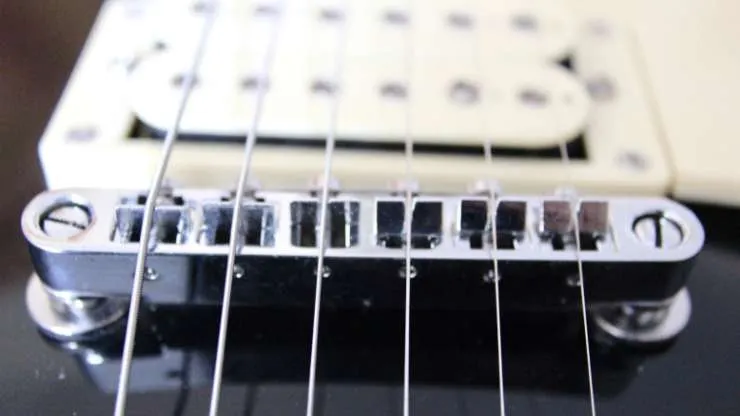You’ve probably spent countless hours perfecting your technique, learning new songs, and choosing a guitar with the best pickups or body type. But have you ever considered your guitar’s bridge? A bridge plays a critical role in a guitar’s playability, tone, and overall performance. In this article, we will discuss the importance of selecting the right guitar bridge, explore the different types of bridges, and help you decide what type of guitar bridge is best for you.
What Is a Guitar Bridge?
A guitar bridge is an essential component of any stringed instrument. It serves multiple purposes, such as transferring the vibrations of the strings to the guitar body, providing an anchor point for the strings, and allowing the player to adjust the string height and intonation. The guitar bridge plays a crucial role in the instrument’s overall sound, playability, and sustain.
There are several types of guitar bridges, each with its own unique characteristics and functionalities. Different types of bridges can be found on various instruments, including electric, acoustic, and classical guitars. Some bridges provide maximum tuning stability, while others allow you to create expressive vibrato effects. The type of bridge that is best for you will depend on the style of music you play, your playing technique, and your preferences.
Importance of the Right Guitar Bridge
The right guitar bridge can significantly impact your instrument’s playability, tone, and overall performance. A well-made bridge will provide a comfortable playing experience, allowing you to play for extended periods without experiencing hand fatigue. A quality bridge can also enhance sustain and resonance, contributing to a rich and full tone.
Conversely, a poorly designed or ill-fitting bridge can cause various issues, including poor intonation, buzzing, and difficulty in playing. This can be frustrating for any guitarist, regardless of skill level. Therefore, it’s essential to choose the right type of guitar bridge that complements your playing style and helps you achieve the desired sound and performance from your instrument.
Electric Guitar Bridges
The world of electric guitar bridges is vast and varied, with a range of different types available to suit varying playing styles and preferences. Here, we’ll take a closer look at some of the most popular electric guitar bridges and their characteristics.
Fixed Bridges
As the name suggests, fixed bridges are secured to the guitar body and do not move. This type of bridge is known for its simplicity, stability, and ease of use. Examples of fixed bridges include:
-
Tune-O-Matic Bridge: The Tune-o-matic bridge is a popular choice for many guitarists. This bridge features individual saddles for each string, allowing you to adjust the string height and intonation easily. The Tune-o-matic bridge provides excellent sustain and is commonly found on Gibson guitars like the Les Paul and SG.
-
Hardtail Bridge: The hardtail bridge is another fixed bridge option that is quite similar to the Tune-o-matic bridge. However, the hardtail bridge does not have the tailpiece found on the Tune-o-matic, giving it a more streamlined appearance. The hardtail bridge is also known for its excellent sustain and stability, making it a popular choice among guitar players who prefer a more straightforward design.
-
String-through-body Bridge: The string-through-body, or string-thru, bridge is a fixed bridge that allows the strings to pass through the guitar body, providing additional anchor points for the strings. This design is known to increase sustain and resonance, making it a popular choice for guitarists seeking a more vibrant and full-bodied sound.
Tremolo Bridges
Tremolo bridges, also known as vibrato bridges, are designed to allow the player to create pitch variations by moving the bridge up or down. These bridges add expression to your playing but can also be more challenging to maintain and set up. Popular tremolo bridges include:
-
Synchronised Tremolo Bridge: The synchronised tremolo, often called a “Strat-style” tremolo, is a popular bridge found on many Fender guitars, such as the iconic Stratocaster. This bridge allows you to create subtle pitch variations by manipulating the tremolo arm, adding a unique character to your playing. The synchronised tremolo is known for its smooth action and relatively easy setup.
-
Floyd Rose Bridge: The Floyd Rose bridge is a double-locking tremolo system designed for extreme pitch variations and dive-bombing effects. This bridge features a locking nut and fine tuners, allowing you to maintain excellent tuning stability even during aggressive playing. However, the Floyd Rose bridge can be more challenging to set up and maintain, making it a better choice for experienced players.
-
Bigsby Bridge: The Bigsby bridge is a vibrato system often found on hollow-body and semi-hollow-body guitars. This bridge provides a more subtle pitch variation than the Floyd Rose and is known for its smooth, vintage-style vibrato. The Bigsby bridge can also be somewhat challenging to set up and maintain, making it a better choice for players who are comfortable with guitar maintenance.
Acoustic Guitar Bridges
Acoustic guitar bridges are typically more straightforward than electric guitar bridges, with fewer variations in design. However, there are still some differences between various acoustic guitar bridges that can impact the instrument’s sound and playability. Here are some of the most commonly found acoustic guitar bridges.
Pin Bridge
The pin bridge is perhaps the most common type found on acoustic guitars. This bridge features a series of holes through which the strings are threaded and secured using bridge pins. The pin bridge is known for its simplicity and effectiveness in transferring the string vibrations to the guitar body, resulting in a rich and resonant sound.
Pinless Bridge
The pinless bridge is an alternative to the traditional pin bridge and is found on some acoustic guitars, particularly those with a more modern design. This bridge eliminates the need for bridge pins, as the strings are anchored directly to the bridge. Some players think the pinless bridge provides better string-to-body contact, resulting in improved sustain and resonance. However, others argue that the difference in sound is negligible and that the choice between a pin and pinless bridge comes down to personal preference.
Classical Guitar Bridge
The classical guitar bridge is specifically designed for use with nylon strings and is found on classical and flamenco guitars. This bridge features a flat and wide design, with slots for each string to pass through and wrap around the back of the bridge. The classical guitar bridge provides a balanced and warm sound, ideal for the intricate fingerpicking techniques used in classical and flamenco music.
Factors to Consider When Choosing a Guitar Bridge
When selecting the best electric guitar bridge for your instrument, consider the following factors:
-
Playing style: Your playing style will heavily influence your choice of bridge. A tremolo bridge may be the best option if you frequently use vibrato effects or play genres like heavy metal and hard rock. Conversely, a fixed or locking bridge might be more suitable if you prioritise tuning stability and sustain.
-
Tone: Different types of guitar bridges can noticeably impact your guitar’s tone. For example, tremolo bridges tend to produce a warmer and more resonant sound, while fixed bridges offer a brighter and more focused tone. Consider the tonal characteristics you want to achieve with your instrument when selecting a bridge.
-
Maintenance and ease of use: Some guitar bridges are more challenging to set up and maintain than others. A fixed bridge might be your best bet if you prefer a low-maintenance option. However, a tremolo or locking bridge can provide additional performance benefits if you’re willing to spend more time on setup and adjustments.
Adjusting and Maintaining Your Electric Guitar Bridge
Properly adjusting and maintaining your electric guitar bridge is crucial for optimal performance and playability. Here are some essential tips for keeping your bridge in top condition:
-
Intonation adjustment: Make sure your guitar’s intonation is correctly set by adjusting the saddles on your bridge. This will ensure that your guitar plays in tune across the entire fretboard.
-
Action adjustment: You can adjust the bridge height to achieve your desired string action (the distance between the strings and the fretboard). Guitars with lower action are generally easier to play but may result in fret buzz, while higher action can provide better tone and sustain but may be more challenging to play.
-
Cleaning and lubrication: Regularly clean your bridge and apply a small amount of lubricant to any moving parts, such as the tremolo arm and saddle screws. This quick and easy maintenance can help prevent corrosion and ensure smooth operation.
Upgrading Your Guitar with a New Bridge
If you’re unsatisfied with the performance or tone of your current electric guitar bridge, upgrading to a new bridge can provide significant improvements. Many aftermarket options are available, and you can choose from various guitar bridges to suit your preferences and playing style. When upgrading your bridge, it’s essential to ensure the new bridge is compatible with your guitar’s body and existing hardware.
If you aren’t entirely comfortable swapping the bridge by yourself, you can always seek the help of an experienced luthier to ensure your upgrade is correctly installed and set up. At the very least, consulting with a qualified guitar technician is a good idea before significantly modifying your instrument.
What Type of Guitar Bridge Is Best?
Now that we have explored the various types of guitar bridges, the question remains: What type of guitar bridge is best? The answer to this question ultimately comes down to your preferences, playing style, and the music you enjoy playing.
If you are an electric guitar player who values simplicity, stability, and ease of use, a fixed bridge may be your best choice. However, a tremolo bridge could be more suitable if you enjoy experimenting with pitch variations and expressive playing techniques.
For acoustic guitar players, choosing between a pin and pinless bridge may come down to personal preference and the specific sound you want to achieve. Classical guitar players will naturally gravitate towards the classical guitar bridge, as it is specifically designed for use with nylon strings.
Finding the Perfect Bridge for Your Electric Guitar
Now that you know everything there is to know about bridges, head over to our Finder tool to start the search for your perfect guitar. Along with choosing your preferred bridge type, you can specify your budget, pickups, and body type to quickly find the instrument of your dreams.

